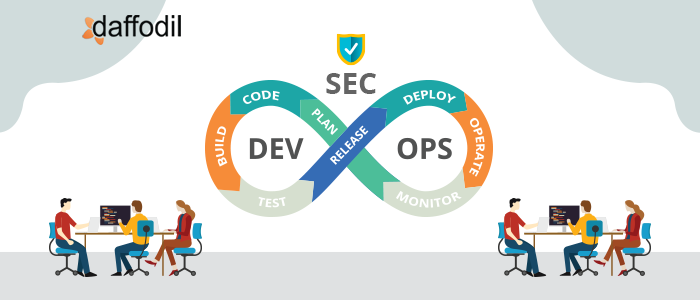
The COVID-19 pandemic accelerated the digitization of business processes. While numerous tools supported rapid digitization, it somewhere impacted security, observability, traceability, and compliance of the digital solutions.
To deal with the loopholes in development, businesses are turning to DevSecOps, an approach that infuses risk mitigating activities throughout the delivery pipeline. This, as a consequence, gives an idea about how an application is progressing, who is deploying what, when, and in what environment.
But, why DevSecOps when the traditional Application Security Testing (AST) already exists? Well, both the approaches to mitigate risks in the development cycle have a significant impact, there are some differences between the two.
How is DevSecOps Different from Application Security Testing?
In a traditional approach to security testing, a dedicated team is aligned to take care of application security. This team performs manual checkups in the mid-to-late phase of the SDLC. On the other hand, DevSecOps is jointly handled by the security and development teams. Herein, an application is continuously tested throughout the development cycle.
In application security testing, specialized tools are used. These tools aren’t linked with the development of the toolchain. Whereas, in a DevSecOps approach, the tools are directly linked with the development toolchain.
Manual testing procedure enlists vulnerabilities that require significant human triage. On the contrary, the DevSecOps approach includes automation testing wherein human interventions are expected only at high-risk issues.
In a nutshell, DevSecOps enables the teams to introduce security standards without compromising with the development process. The best part is, some of the critical bugs in the system can be discovered and fixed at an initial stage. This not only reduces risk but also accelerates the pace of the development cycle.
How does DevSecOps achieve this? Let’s figure it out in the upcoming segment.
How can DevSecOps Mitigate Security Risks?
Many of the DevOps practices provide an opportunity to secure an application. Automation, fast feedback loops, consistent release cycle, etc. are some of the components that make security and auditing capability a built-in feature of DevOps processes. Beyond this, DevSecOps provide some additional benefits that make it a must-have process of today’s software development cycle.
1. DevSecOps makes Software Delivery Cycle Observable
One of the significant advantages of DevSecOps is it allows the team to trace the journey of development. For example, what user stories are being deployed and managed in the runtime environment. With DevSecOps to manage the delivery pipeline, the development team can prove the existence of every process within the cycle.
2. DevSecOps creates Confidence in the Delivery Cycle
DevSecOps creates a trustful relationship between the stakeholders and the IT team. It gives confidence to the stakeholders, assuring what started as a requirement, in the beginning, is continuously updated as a solution.
3. DevSecOps help to Maintain Compliances
Banking, healthcare, federal are some of the industries wherein regulations and compliances play an important role. When DevSecOps practices are adopted, it helps the development teams to ensure that the software solution adheres to the essential and best practices of certain compliance.
4. DevSecOps helps to Deal with Technical Debt
Time-to-market pressure, poor documentation, lack of team collaboration, wrong technical decisions, misunderstanding of business goals are some of the common factors that contribute to technical debt. When this debt comes in the form of vulnerabilities, it raises poor security governance of software development and release processes.
DevSecOps helps to deal with such debts. As security automation is a crucial part of the DevSecOps cycle, it helps to figure out the bugs and vulnerabilities in every phase of the development cycle, ensuring that a clean solution comes out at the end.
5. DevSecOps helps to Use Open Source Code Assuredly
The open-source community welcomes contributions from literally anyone, giving way to malicious code in the environment. Although some open-source packages remove these components from their servers, this process is not always a quick one and is not adopted by everyone. When automated code scanning is performed at different stages of development, it reduces the chance of adding compromised components to the code. This saves the development team from issues at the later stage.
6. DevSecOps Offer Benefits with Cloud
Automated testing and observability are the key drivers of DevSecOps. This software development approach can be extremely helpful when adopted with cloud services. For example, adopting DevSecOps can be a great help during cloud migration. When software is developed in a cloud environment it allows continuous analysis of code, monitors compliance, investigates threats, manages changes, and more.
Incorporating DevSecOps in Software Development Cycle
DevSecOps is gaining popularity for its ability to provide observability, visibility, and audibility to the software development cycle. As businesses shift their development approach from Agile to DevOps, they can release software applications, fixes, and updates, faster than ever. While DevOps introduces frequent and stringent security checks, it introduces the fear and risk of development slow down. This is where DevSecOps help.
The tools and techniques in DevSecOps ensure that the development cycle is disturbed as little as possible. However, the approach involves methodologies and people that help in keeping the speed of the development cycle consistent.
DevSecOps have unlimited benefits to offer to a software development cycle. If a scalable software solution is in your pipeline, then incorporating DevSecOps can prove to be advantageous. To understand how this approach can be helpful to your software solution, you can schedule a consultation call with our DevOps experts who will guide your way to build a secure, qualitative solution.



